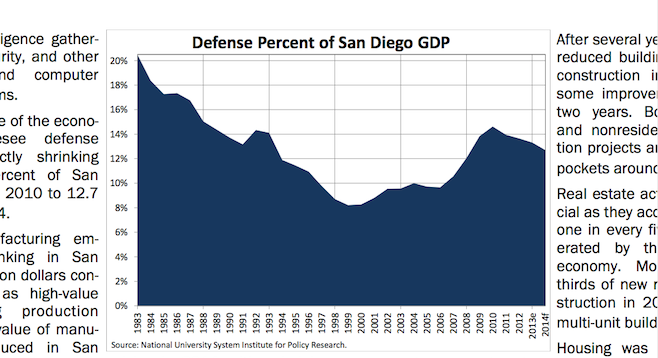 Facebook
Facebook
 X
X
 Instagram
Instagram
 TikTok
TikTok
 Youtube
Youtube

Last year, the San Diego economy, adjusted for inflation, grew faster than both the state and the nation. This year, though, the standings will flip, says Kelly Cunningham, economist for the National University System Institute for Policy Research. The inflation-adjusted local economy will grow by only 1.8% versus 2% for the state and 2.2% for the nation.
There will be several flies in the ointment, according to Cunningham, and one will be defense spending: it is forecast to shrink from 14.6% of the local economy in 2010 to 12.7% this year. The county's population will grow by less than 1% — a mere 0.72% to 3.2 million. An estimated 19,400 more Americans will leave San Diego than arrive. This will be almost offset by net international migration of 18,000. The natural increase, or babies, will drop slightly to 24,400 from 24,600 last year.
Consumer inflation, which was only 1.2% last year, will rise to 2.1% this year. Inflation-adjusted consumer spending, as measured by taxable sales, has still not come back to the levels prior to the Great Recession.

There are many positives. There will be 9000 new housing units, overwhelmingly multiples, but again, this remains far below levels of earlier in the decade, when units almost hit 18,000.
San Diego's unemployment rate is expected to fall to 6.8% from last year's 7.3%, but, says Cunningham, "Much of the improvement in the unemployment rate results from shrinking numbers looking for work." Indeed, in the late 1990s, more than 67% of San Diegans of working age were in the civilian workforce. That had dropped to below 63% in the middle of last year.
There is bright news in tech and biotech industries. They account for 11% of the county's jobs and 22% of payroll wages. That's because as of last year, the average tech wage was $104,200 versus $54,325 for the county as a whole. The industry will do well this year, says Cunningham.


Last year, the San Diego economy, adjusted for inflation, grew faster than both the state and the nation. This year, though, the standings will flip, says Kelly Cunningham, economist for the National University System Institute for Policy Research. The inflation-adjusted local economy will grow by only 1.8% versus 2% for the state and 2.2% for the nation.
There will be several flies in the ointment, according to Cunningham, and one will be defense spending: it is forecast to shrink from 14.6% of the local economy in 2010 to 12.7% this year. The county's population will grow by less than 1% — a mere 0.72% to 3.2 million. An estimated 19,400 more Americans will leave San Diego than arrive. This will be almost offset by net international migration of 18,000. The natural increase, or babies, will drop slightly to 24,400 from 24,600 last year.
Consumer inflation, which was only 1.2% last year, will rise to 2.1% this year. Inflation-adjusted consumer spending, as measured by taxable sales, has still not come back to the levels prior to the Great Recession.

There are many positives. There will be 9000 new housing units, overwhelmingly multiples, but again, this remains far below levels of earlier in the decade, when units almost hit 18,000.
San Diego's unemployment rate is expected to fall to 6.8% from last year's 7.3%, but, says Cunningham, "Much of the improvement in the unemployment rate results from shrinking numbers looking for work." Indeed, in the late 1990s, more than 67% of San Diegans of working age were in the civilian workforce. That had dropped to below 63% in the middle of last year.
There is bright news in tech and biotech industries. They account for 11% of the county's jobs and 22% of payroll wages. That's because as of last year, the average tech wage was $104,200 versus $54,325 for the county as a whole. The industry will do well this year, says Cunningham.
Comments